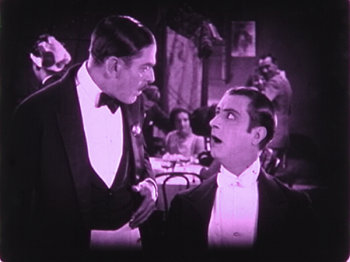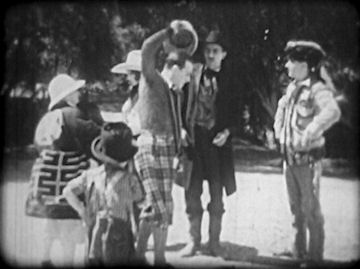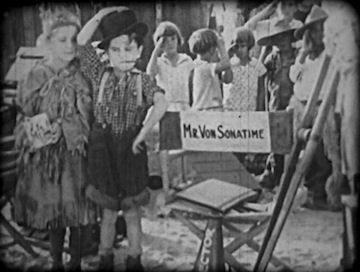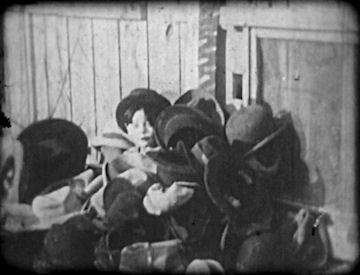Blog Archives
William Tells (FBO, 1924)
 William Tells (FBO, 1924)
William Tells (FBO, 1924)
Directed by Malcolm St. Clair
Starring Alberta Vaughn
William Tells (1924) is the sixth episode in The Telephone Girl series. It, along with all the other episodes, was originally a two-reeler, but my print is not complete. What I’ve got seems to be most of the first reel minus the main title, then a big jump, then the final few minutes of the second reel minus the end card. Who knows why it’s cut like that, but I’ve also got a print of Laughing Gas (1924) from the same source that’s similarly edited. It’s an original 35mm nitrate print.
Gladys (Alberta Vaughn) and Hazel (Gertrude Short), formerly switchboard operators at the St. Moe Hotel in New York, have been lured to Paris by Julius de Haven (Arthur Rankin), a movie producer who promised to make them stars. Stardom, however, seems not to be forthcoming and the two girls are holed-up in their hotel room until they find some way back to the States.
 After them are Jerry (Albert Cooke) and Jimmie (Kit Guard), the former being St. Moe’s house detective and the latter its bellhop. They’re on the train from Beauvais. In the same compartment is a gendarme. It seems like they might already be acquainted but they certainly are after the trio gets into some mishaps with a live turkey and some butter-throwing shenanigans.
After them are Jerry (Albert Cooke) and Jimmie (Kit Guard), the former being St. Moe’s house detective and the latter its bellhop. They’re on the train from Beauvais. In the same compartment is a gendarme. It seems like they might already be acquainted but they certainly are after the trio gets into some mishaps with a live turkey and some butter-throwing shenanigans.
Skipping a bit and the girls are attempting to order breakfast at a Parisian cafe — attempting, I say, because even with their phrasebook they can’t do much better than ask “mushoo” to “bringez” them “la hammo and eggo”. At a nearby table is William Van Cleve II (Mario Carillo), who pays close attention to the girls. What his intent is can only be guessed by his motto “Sheik and Ye Shall Find”, because now we skip to the end:
It’s night time at the bustling Cafe Oo-La-La. The girls are there, as are Jerry and Jimmie, who are still trying to duck the police. Gladys and Hazel are accompanied by Van Cleve, who carries himself with quite an aristocratic bearing. It’s a slight embarrassment when the  waiter recognizes him as a man of his own profession and demands repayment of a three-dollar loan he made him. Just then, the gendarme appears and moves to arrest Jerry and Jimmie. They get away in confusion when the scuffle between Van Cleve and the waiter breaks into an enormous fight that engulfs the entire restaurant.
waiter recognizes him as a man of his own profession and demands repayment of a three-dollar loan he made him. Just then, the gendarme appears and moves to arrest Jerry and Jimmie. They get away in confusion when the scuffle between Van Cleve and the waiter breaks into an enormous fight that engulfs the entire restaurant.
I think my summary makes the film sound more slapstick than it is. Most of the humor comes from the very jokey and referential titles (it namechecks A Woman of Paris and The Sheik).
If I remember from the research I did when I acquired the print back in 2009, The Telephone Girl is an orphaned work — meaning, it’s still under copyright, but who exactly owns it isn’t clear. Robertson-Cole became FBO became RKO, which finally went kaput in 1957. The library was split up mostly between United Artists and MBP. MGM took over most of MBP’s holdings, and in turn were taken over by Turner. That’s just U.S. video rights — international rights are scattered to the four winds and theatrical rights, now that’s a whole ‘nother kettle of fish. All that can safely be said is that the copyright on the series was renewed on January 10th, 1952 and is therefore still in force.
 I’m only aware of one other extant episode — episode four, Sherlock’s Home, survives on 16mm.
I’m only aware of one other extant episode — episode four, Sherlock’s Home, survives on 16mm.
I suppose William Tells is all right. Not terribly funny, but not a groaner either. Some of the titles are cute — I’m particularly fond of Hazel being “sorry to hear Napoleon is dead. She didn’t even know he was sick.”
My rating: Meh.
In other news, The Doll-House Mystery should have already been out, but I’ve had a minor illness and am running behind. It shouldn’t take much longer, I hope. The next video, a lovely Kodascope of Tough Luck and Tin Lizzies, is already scanned and waiting in the wings.
Mickey’s Movies (FBO, 1928)
 Mickey’s Movies (FBO, 1928)
Mickey’s Movies (FBO, 1928)
Directed by Earl Montgomery
Starring Mickey Rooney
Back when Mickey Rooney died, I intended to watch Mickey’s Movies (1928). I knew I had a nice print of the film, but when I went to find it, it simply wasn’t there. That was the point I realized the film collection had grown too large to remain unorganized and uncatalogued (at that point, it was something like 450 titles). It spurred me to smarten-up in that regard, but even after systematically going through every reel, Mickey’s Movies continued to elude me. It wasn’t until about six weeks ago that it reappeared. It wasn’t hiding anywhere unusual — it was just mixed in among some other 16mm two-reelers — and for the life of me, I can’t explain how it escaped noticed for so long.
I’ve said before about the two reel comedies that Educational put out, that they’re really one reel of actual story and another of pure filler. Mickey’s Movies is quite similar in that regard, but it at least makes some effort to mix the two together.
The Mickey McGuire series was one of the countless Our Gang rip-offs floating around in the late ‘20s. Its star, Mickey McGuire (Mickey Rooney), is the leader of a gang of poor kids who get into various comic scrapes.
 Mickey’s Movies begins with a nigh-incomprehensible jumble of scenes that veer wildly from building a clubhouse to fishing to some kind of kid-run carnival to puppies chasing chickens. In isolation, all the components more or less make sense, but don’t ask me to explain how one relates to another. About five minutes in, we arrive at the meat of the film:
Mickey’s Movies begins with a nigh-incomprehensible jumble of scenes that veer wildly from building a clubhouse to fishing to some kind of kid-run carnival to puppies chasing chickens. In isolation, all the components more or less make sense, but don’t ask me to explain how one relates to another. About five minutes in, we arrive at the meat of the film:
Mickey and the gang stumble upon a movie shoot. The Superba Film Company are taking a western scene, the villain and the hero are fighting, and the director — Mr. Von Sonatime — is not having it. “Rotten!! Terrible!! Awful!!” he screams as he throws his hat to the ground. A PA follows him with a steady supply of fresh hats.
Superba seems to have requisitioned the Scorpion Club (the Mickey gang’s hideout) as a dressing room. This will not do. Mickey sets the guard dog on the film company and chases them into the lake. After appointing himself as the new director, Mickey begins shooting the film himself, adopting the same mannerisms of Von Sonatime, including hat-tossing.
After a good ten minutes of well-plotted action, the film begins to dip back into random nonsense, but at least now it’s all thematically connected to filmmaking. Little Chocolate (Hannah Washington), Mickey’s right-hand gal, has been assigned to hat duty. As Mickey goes through more and more hats, she has to find some way of keeping  up. At the end, she’s got a hat Gatling gun from somewhere that buries Mickey in hats and brings the film to a close.
up. At the end, she’s got a hat Gatling gun from somewhere that buries Mickey in hats and brings the film to a close.
If edited down to one reel, I would whole-heartedly recommend Mickey’s Movies. I don’t, as a rule, go in for kid comedies, but this one at least was cute and entertaining. But the random additional footage mixed in really drags it down. If, from market demands, you simply had to pad it out to two reels, I think I prefer Educational’s method of front-loading all the filler in the first reel and letting the second reel stand on its own.
When I pulled up this film’s IMDb page, I saw that it got a review from the late, great F. Gwynplaine MacIntyre. MacIntyre was a divisive figure. His shtick was to find lost films (or what he thought were lost films) on IMDb and write reviews of them, claiming to have seen them through various secret and slightly nefarious channels. His reviews, in reality, were based on contemporary plot synopses, publicity stills, and his own healthy imagination. Some saw him as nothing more than a liar, while others appreciated his work as a kind of performance art. I liked him, but I suppose it helps that I always knew it was pretend. A deeply disturbed person in real life, but that’s neither here nor there.
Anyway, Mickey’s Movies…
My rating: Meh.